In combined surgery candidates, the transabdominal way to locate breast implants are preferred and applied with the abdominoplasty, aspiration lipoplasty and breast augmentation together in indicated cases. In 46 cases, very rare complication rate is observed as 3 cases with seroma in upper epigastric area and no infection or tissue circulation or nervous (sensorial) problems are observed. The technique contains a lower plane abdominoplasty incision, the wet technique saline infiltration to the abdominal area, aspiration lipoplasty following excess skin of the belly and undermining the central line, reaching medial breast regions, and fish hook shaped dissections from the medial supra fascial pectoral areas for the estimated volume of the breast implants differently from the previously described technique. Following the application of the implants, the skin between the breasts over the sternum, reattached to the base of the prepared hole with a fixation suture to facilitate the tunnel obliteration, and plication of rectus fascia and closing the incision of abdominoplasty completes the operation. A drainage provided by flat (7 or 10 mm Jackson-Pratt) drains applied for 48 hours following surgery. External combined garment for abdominoplasty and breast augmentation is applied for six weeks. By this vertical midline single tunneling technique, the previously described TABA surgery can be performed in a shorter operation time and lesser deformity and complication rate. EBM is accepted as Level V, Opinions of respected authorities, based on clinical experience, descriptive studies, or reports of expert committees.
Keywords: Abdominoplasty, Lipoplasty, Breast augmentation
The mammary implant procedures are widely described in details and it is not necessary to make a comment on this subject. The patient with abdominal laxity and/or fat deposits with mammary involutionary athrophy or underdevelopment are requiring two aesthetic procedures as mammary augmentation with abdominoplasty and/or lipoaspiration procedures at the same time. During surgical procedures, the abdominal skin is widely undermined because of the nature of the abdominal aesthetic operation, and at the end of the abdominal procedure, following rectus fascia plication, there will be a very short distance remained between breasts and the dissected abdominal areas. Therefore, it is reasonable to add an extra dissection for a few centimeters more to reach the supra fascial area of the pectoral muscles under the breast tissue from the inferomedial areas of the organs. This area also has a significant advantage as the vascular and nervous entrance of bundles of the breasts not located in that dissection regions. In addition of sharp and blunt dissection of midline skin until it reaches the manibrium sterni, the lateral angulation of the dissection easily reveals a space for the implants and doing it with fingers creates a tunnel wide enough for passage of the implants. Following the control of bleeding and acquiring hemostasis, following application of implants without interfering the breast skin microflora, the only thing remaining to do a drain application into the tunnel and a simple suture to obliterate the tunnel to prevent relocation of the implants and the skin elevation between the breasts over the sternum. The only disadvantage of this procedure is the cases with long body shape is the necessity of dissection reaching up to 15 centimeters to reach the breast area. This problem can be solved by the dissection done by liposuction cannula during the abdominoplasty procedure.1,2
This technique was described by Hinderer in 1975 and it has been used and published with minor modifications or the same technique supporting the describing author3-7 has been used. The main principle of this technique is the preparation of two different tunnels from the upper dissection border of the abdominoplasty, in inferomedial to superolateral direction to reach the implant pouch preparation area.3-5 Following the implant insertion, the obliteration of the tunnels requires some fixation sutures to prevent implant migration and to restore the partially dissected submammary fold. According to the author’s modification, it will not be necessary to prepare two different tunnels in interfered with sub mammary folds and cut and cauterize perforator vessels to support the abdominal flaps circulation, the only one central vertical tunnel prepared on midline vertically to reach 1/3 of the manibrium sterni and angulated to reach the right and left implant insertion area submuscular or sub glandular location. This dissection area is relatively poor for vascular perforators and nerves. The relocation of the abdominal flap is succeeded with a lesser tension at the midline at the suprapubic area. By this method, a fish hook like tunnel is prepared for each breast over the thorax and sub mammary fold integrity is preserved. Following insertion of implants, there is an only one absorbable suture to obliterate the tunnel located over the sternum and insertion of a flat drain between the breasts for 48 hours creates enough negative pressure to drain the fluids and air left in the region. The compressive garments is necessary for 6 weeks and late complications as capsula formation (longest follow up is 11 years and no capsula formation is observed), probably due to absence of breast skin contact with implants by this method. This hypothesis is also mentioned in previous TABA procedure performing authors.1-8 The post operative antibiotics in addition to the implant wash with rifamycine +SF solution, as cephalosporine and an aminoglycozide for 48 hours IV, oral continuation with quinolone for 5 days more.6,7 None of the cases had an infection despite 3 serome formations in perioperative periods. There were no circulation problems in abdominal flaps probably due to lack of tension on midline released from far upper region reaching breast localizations. For the smokers, cessation of smoking for the last five days prior to operation and not to smoke for 3 weeks following the operation, and no complications are observed due to circulation problems Figures 1-7.8,9
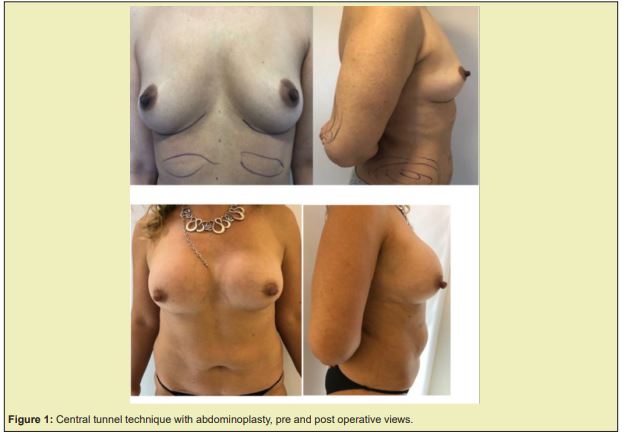
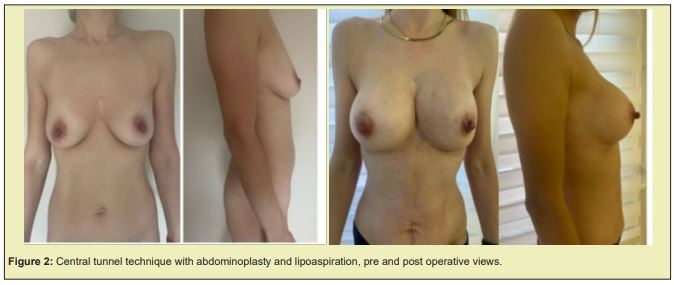
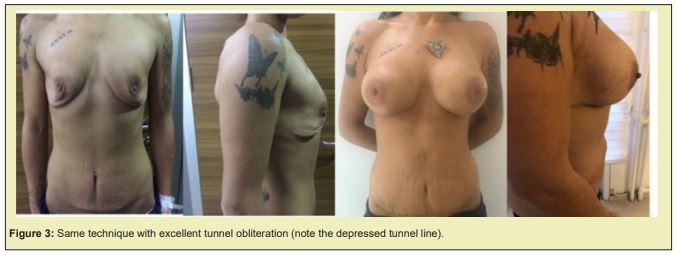
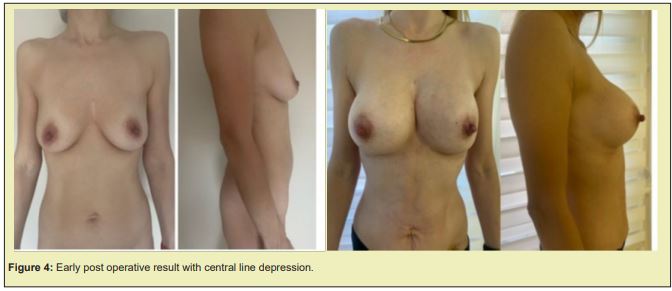
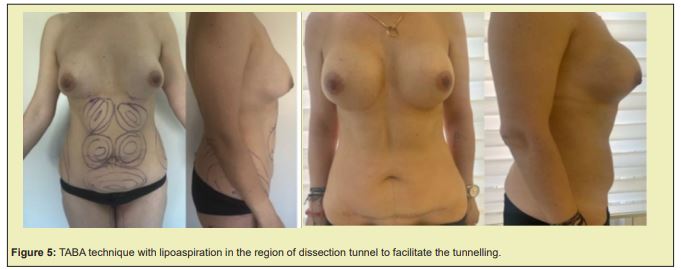
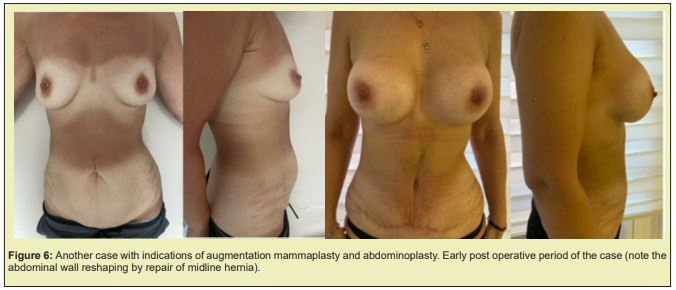
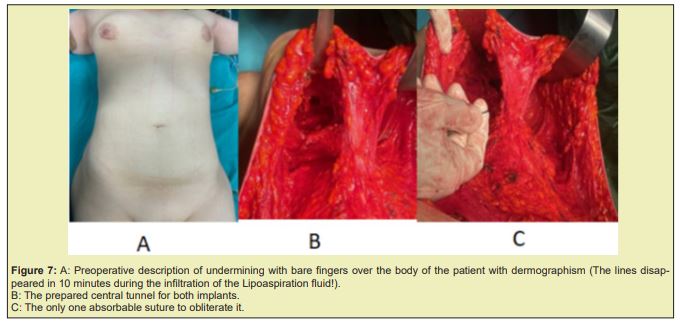
Carefully selected 46 cases ranged between 30 and 52, who are not willing to have another gestation anymore and all of them were experienced breast feeding at least once and or 4 times before. The last pregnancies were not closer than 3 years and 12 of them were post menopausal. 10 cases were smokers and two of them were heavy smokers as more than a package per day, and all of them stopped smoking at least 1 week before and 3 weeks following the surgery. All of the smokers required post operative respiratory support as breathing exercises and expectoration by help of the nurses and physiotherapists to prevent any complication and no problems were observed during the hospital stay. The mean hospital stay was 2 days postoperatively, in one case it was elongated to 4 days due to pulmonary rehabilitation. The complications were very low according to the other breast implants techniques as 3 seromas in upper epigastric regions, probably due to the presence of relatively wider spaces prepared by the surgeon for the tunnel to reach the implant spaces. The fluid accumulated around the implants could be drained by the flat drains stayed there for 4 days from the operation without the high risk of infection.
By looking at these results, it can be concluded that This modification of “Trans Abdominal Breast Augmentation” procedure adds an additional advantage to the technique as relieving the tension on midline performed by abdominoplasty and not to interfere of sub mammary fold integrity and shortening the operation time, and finally by preparing only one tunnel in the region which relatively avascular instead of preparation of two tunnels within the perforator containing areas as described in original technique, reducing the risk of abdominal flap circulation by staying distant enough from the perforators region and reduce the tension on midline of abdominal flap which has the highest risk for circulation problems, to support blood supply of the flaps.
- There is no support or any relation or interaction with any company or people for this research and preparation of the publication.
- This article does not contain any studies with human participants or animals performed by any of the authors.
- For this type of study formal consent is not required.
- Keywords: Breast Augmentation, Combined Esthetic Procedures, Trans Abdominal Breast Implant Application, Silicone Breast Implants, Abdominoplasty with Breast Surgery.
None.
Authors declare that there is no conflict of interest.
- 1. Hinderer UT. The dermolipectomy approach for augmentation mammaplasty. Clin Plast Surg. 1975;2(3):359–369.
- 2. Bhatt RA, Iyengar RJ, Karacaoglu E, et al. Transabdominal Breast Augmentation: A Review of 114 Cases Performed over 14 Years. Plast Reconstr Surg. 2017;140(3):476–487.
- 3. Steven Wallach. Understanding a Transabdominal Breast Augmentation (TABA), MD Transabdominal breast augmentation (TABA). Aesthetic Surgery Journal. 2004;24:373–378.
- 4. Planas J. Introduction of breast implants through the abdominal route. Plast Reconstr Surg. 1976;57(4):434–437.
- 5. Stümpfle RL, Piccinini PS, Zanin EM. Transabdominal Breast Augmentation With Silicone Gel Implants. Annals of Plastic Surgery. 2021;87(2):126–131.
- 6. Barrett BM Jr, Kelly MV. Combined abdominoplasty and augmentation mammaplasty through a transverse suprapubic incision. Ann Plast Surg. 1980;4(4):286–291.
- 7. Rachel Sullivan, Reena Bhatt, Richard J. Zienowicz Large Series Results Supporting the Merits of Transabdominal Breast Augmentation. asps.confex.com. 2009.
- 8. Rinker B, Jack JM. Subpectoral breast augmentation through the abdominoplasty incision. Ann Plast Surg. 2007;58(3):241–245.
- 9. Wallach SG. Maximizing the use of the abdominoplasty incision. Plast Reconstr Surg. 2004;113(1):411–417.

